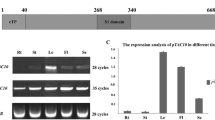Abstract
Using a heterologous probe, we localized thepetB andpetD genes on a 2.4-kbpBamH I fragment ofPopulus deltoides ctDNA. The fragment was cloned and characterized by means of nucleotide sequencing. Analysis of the complete nucleotide sequence of this fragment revealed the presence of a 213-codon exon exhibiting more than 90% homology with thepetB gene nucleotide sequence of higher plants. We identified a mini-exon and of thepetD gene downstream from this exon. The presence of conserved splice site sequences suggests that the poplarpetB andpetD genes contain group II introns. Furthermore, these genes constitute an operon withPSII genes,psbB, psbT, andpsbH, and cotranscribe with them as a polycistronic message. Northern hybridization analysis with total RNA prepared from leaves at different developmental stages revealed a quantitative increase in the primary transcript in mature leaves.
Similar content being viewed by others
Abbreviations
- MOPS:
-
3-(N-morpholino)-propane sulfonic acid
- NC:
-
nonconserved
- NS:
-
nonsynonymous substitutions
- nt:
-
nucleotide
- RBS:
-
ribosomal binding site
- S:
-
similar
- SC:
-
semiconserved
- SS:
-
synonymous substitutions
- ctDNA:
-
chloroplast DNA
References
Dixit Rekha, Trivedi PK, Nath P, and Sane PV (1999) Organization and post-transcriptional processing of thepsbB operon from the chloroplasts ofPopulus deltoides. Curr Genet 36: 165–172.
Feinberg AP and Vogelstein B (1984) A technique for radiolabelling DNA restriction endonuclease fragments to high specific activity. Anal Biochem 137: 266.
Freyer R, Hoch B, Neckermann K, Maier RM, and Kossel H (1993) RNA editing in maize chloroplasts is a processing step independent of splicing and cleavage to monocistronic mRNAs. Plant J 4: 621–629.
Fukuzawa H, Yoshida T, Kohchi T, Okumura T, Sawano Y, and Ohyama K (1987) Splicing of group II introns in mRNA coding for cytochrome b6 and subunit IV in liverwort.Marchantia polymorpha chloroplast genome. FEBS Lett 220: 61–66.
Haley J and Bogorad L (1990) Alternative promoters are used for genes within maize chloroplast polycistronic transcription units. Plant Cell 2: 323–333.
Heinemeyer W, Alt J, and Herrmann RG (1984) Nucleotide sequence of clustered genes for apocytochrome b6 and subunit IV of cyt b6/f complex in spinach plastid chromosome. Curr Genet 8: 543–549.
Hirose T, Wakasugi T, Sugiura M, and Kossel H (1994) RNA editing of tobaccopetB mRNAs occurs both in chloroplast and non-photosynthetic proplastids. Plant Mol Biol 26: 509–513.
Hong L, Stevenson JK, Roth WB, and Hallick RB (1995)Euglena gracilis chloroplastpsbB, psbT, psbH andpsbN gene cluster: regulation ofpsbB-psbT pre-mRNA processing. Mol Gen Genet 247: 180–188.
Hurt E and Hauska G (1981) A cytochrome f/b6 complex of five polypeptides with plastoquinol-plastocyanin-oxidoreductase activity from spinach chloroplasts. Eur J Biochem 117: 591–599.
Johnson CH and Schmidt GW (1993) ThepsbB gene cluster of theChlamydomonas reinhardtii chloroplast: Sequence and transcriptional analysis ofpsbN andpsbH. Plant Mol Biol 22: 645–658.
Kallas T, Spiller S, Malkin R (1988) Characterization of two operons encoding the cyt b6/f complex of the cyanobacterium Nostoc PCC7906: Highly conserved sequences but different gene organization than in chloroplast. J Biol Chem 263: 14334–14342.
Lang JD and Haselkorn R (1989) Isolation, sequence and transcription of the gene encoding the photosystem II chlorophyll-binding protein, CP-47, in the cyanobacteriumAnabaena 7120. Plant Mol Biol 13: 441–456.
MacDonald RJ, Swift GH, Przybyla AE, and Chirgwin JM (1987) Isolation of RNA using guanidinium salts. Methods Enzymol 152: 219–223.
Monde RA, Greene JC, and Stern DB (2000) Disruption ofpetB-petD intergenic region in tobacco chloroplasts affectspetD RNA accumulation and translation. Mol G Genetics 263(4): 610–618.
Monde RA, Schuster G, and Stern DB (2000) Processing and degradation of chloroplast mRNA. Biochimie 82: 573–582.
Myers EW and Miller W (1988) Optimal alignment in linear space. Comp App Biosci 4: 11–17.
Palmer JD (1986) Isolation and structural analysis of chloroplast DNA. Methods Enzymol 118: 167–186.
Piechulla B (1988) Plastid and nuclear mRNA fluctuations in tomato leaves-diurnal and circadian rhythmicity during extended dark and light periods. Plant Mol Biol 11: 345–353.
Rock CD, Barkan A, and Taylor WC (1987) The maize plastidpsbB-psbF-petB-petD gene cluster: Spliced and unsplicedpetB andpetD RNAs encode alternative products. Curr Genet 12: 69–77.
Sambrook J, Fritsch EF, and Maniatis T (1989) Molecular Cloning: A Laboratory Manual, 2nd ed. Cold Spring Harbor Laboratory Press, Cold Spring Harbor, NY.
Sanger F, Nicklen S, and Coulson AR (1977) DNA sequencing with chain terminating inhibitors. Proc Natl Acad Sci USA 74: 5463–5467.
Schrubar H, Wanner G, and Westhoff P (1990) Transcriptional control of plastid gene expression in greeningSorghum seedlings. Planta 183: 101–111.
Sharp PM (1991) Determinants of DNA sequence divergence betweenEscherichia coli andSalmonella typhimurium, codon usage, map position and concerted evolution. J Mol Evol 33: 23–33.
Sharp PM and Li WM (1987) The codon adaptation index-a measure of directional synonymous codon usage bias and its potential applications. Nucl Acids Res 15: 1281–1295.
Tanaka M, Obokata J, Chunwongse J, Shinozaki K, and Sugiura M (1987) Rapid splicing and stepwise processing of the transcript from thepsbB operon in tobacco chloroplasts: Determination of the intron sites inpetB andpetD. Mol Gen Genet 209: 427–431.
Wakasugi T, Hirose T, Horihata M, Tsudzuki T, Kossel H, and Sugiura M (1996) Creation of a noval protein-coding region at the RNA level in black pine chloroplasts. The pattern of RNA editing in the gymnosperm chloroplast is different from that in angiosperms. Proc Natl Acad Sci USA 93: 8766–8770.
Westhoff P and Herrmann RG (1988) Complex RNA maturation in chloroplasts: ThepsbB operon from spinach. Eur J Biochem 171: 551–564.
Author information
Authors and Affiliations
Corresponding author
Rights and permissions
About this article
Cite this article
Dixit, R., Trivedi, P., Nath, P. et al. Characterization ofpetB andpetD genes of thePopulus deltoides chloroplastpsbB operon. Plant Mol Biol Rep 20, 357–368 (2002). https://doi.org/10.1007/BF02772123
Published:
Issue Date:
DOI: https://doi.org/10.1007/BF02772123




